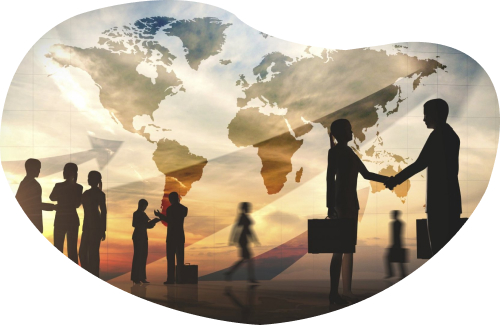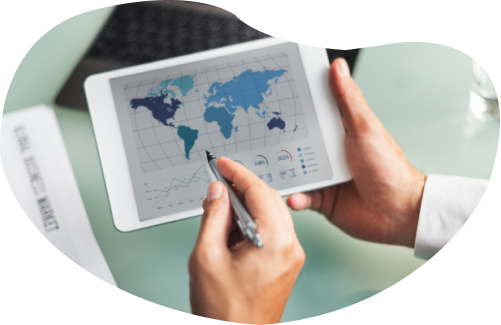The global MLM industry earned over $186 billion in revenue in 2023—with more than 125 million active distributors worldwide. Top MLM markets include countries like the United States, China, South Korea, Germany, and Japan.
We can thank the internet for such a rapid rise and global expansion.
However, reaching a global audience is not the sole objective for MLM businesses. Powering through an array of hurdles such as communicating with customers in regional languages, different currencies, cultural nuances, and regulatory requirements is what makes an MLM business set up shop globally. This is where internationalization becomes fundamental.
Internationalization enables MLM platforms to adapt their operations to regional changes, without making drastic changes to the workforce. In this blog, this is what we are going to talk about—how internationalization features can help expand your MLM business globally.
The potential of cross-border operations
Many MLM distributors often tend to fixate on saturated domestic markets—where growth often stagnates but competition magnifies. What they don't see is beyond familiar borders is the opportunity for international expansion. Markets across Southeast Asia, Latin America, and parts of Africa and Eastern Europe are experiencing a surge in middle-class growth. This explains the increased interest in entrepreneurial income models such as direct selling.
According to the World Federation of Direct Selling Associations (WFDSA), over 80% of global direct sales revenue in 2023 came from outside North America, with Asia-Pacific accounting for 44%, followed by Americas at 24%, and Europe at 21%. With a surge in the middle class, people are constantly looking for ways to make an extra income. If not that, then they seek personal growth, and flexibility at work—which is everything the network marketing sector offers.
So why aren't more MLM businesses grabbing these opportunities instantly?
Historically, going global meant basic translation and hope for the best. But with modern MLM platforms adapting to new trends, that's not the case anymore. Advanced internationalization (i18n) capabilities now allow platforms to go far beyond simple language toggles. They’re built with the tools to:
Comply with international legal and tax regulations (like GDPR in Europe, or GST in India).
Adapt payment systems to local currencies and methods (e.g., M-Pesa in Kenya, UPI in India).
Deliver content that aligns with regional customs and marketing norms.
Adjust compensation plans based on regional economic conditions and incentive models.
Global MLM growth isn’t about copy-pasting what worked at home. It’s about adaptation. In Japan, for instance, MLM success often hinges on deep relationship-building and group consensus, while in Latin America, personal charisma and speed of connection play a more dominant role.
This means that platform design must not only handle localization technically, but also support different models of trust, hierarchy, and community interaction.
Internationalization: Beyond basic translation
Internationalization is often misunderstood—still reduced to the perception of “just translating the website.” However, that mindset dramatically underestimates the depth and sophistication now available in modern MLM platforms. Companies are now deploying multi-layered internationalization stacks that not only localize user experiences but also adapt operations to local laws, economies, and cultures—all in real time.
Let’s break down the key components responsible for this transition:
1. Regulatory compliance frameworks
Legacy platforms relied on manual legal reviews and one-size-fits-all policies to expand into new markets which is a costly and reactive process. In contrast, modern MLM platforms now embed adaptive compliance engines that automatically align platform behavior with local regulations.
These systems can update compensation plans, operational workflows, and marketing permissions based on country-specific legal requirements such as GDPR in Europe, DSA standards in India, or tax regulations in LATAM markets.
Some leading platforms come with in-built compliance templates for over 50 jurisdictions, significantly accelerating the business operations. Instead of starting with a blank legal slate, companies can launch confidently, knowing their platform is primed for compliant operation from day one.
2. Cultural intelligence systems
Translation alone doesn’t help with understanding the essence of a region's culture. That’s why advanced platforms are implementing cultural intelligence (CQ) systems—frameworks designed to tailor user experiences based on deep cultural insights.
For instance:
In individualistic cultures (e.g., US, UK), recognition programs prioritize personal achievement.
In collectivist cultures (e.g., Japan, South Korea), team success is celebrated more visibly.
This cultural nuance influences:
Onboarding tutorials and training tone.
Event cadence and social proof structures.
Commission dashboards and goal-setting UX.
These elements are core to increase user engagement and retention. A mismatch between platform tone and cultural expectations can lead to distributor churn or underperformance, even with a compelling product or comp plan.
3. Geo-specific compensation modeling
Perhaps the most advanced internationalization capability is geo-specific compensation modeling. Rather than offering a global flat-rate commission model, modern MLM platforms use localized economic data and behavioral psychology to customize compensation structures.
For example:
In high-cost markets like Scandinavia or Singapore, plans may offer higher upfront bonuses to account for distributor overhead.
In growing economies, compensation models may emphasize long-term incentives or team-building tiers that support sustainable growth and affordability.
These tools now include scenario simulation engines, enabling companies to forecast market-specific performance before launch—eliminating much of the guesswork and financial risk that previously defined international rollouts.
How can MLM Businesses Improve their Internationalization?
- Adopt regulatory compliance frameworks
- Enhance understanding of regional cultures
- Geographically aligned compensations
The overlooked dimensions of international operations
When businesses plan for international growth, the spotlight often lands on the visible elements—language support, localized websites, and marketing campaigns. But sustainable global success in MLM depends on something far less glamorous yet far more powerful: the operational infrastructure working quietly in the background.
Many MLM companies understand that internationalization isn't just a customer-facing effort—it's an end-to-end operational transformation. Here are three underrated, but essential pillars enabling this transformation:
1. Cross-border inventory orchestration
Inventory management across borders has traditionally been a logistical nightmare for MLM companies—balancing demand, minimizing excess stock, and ensuring timely delivery while keeping costs under control. Today, however, advanced MLM platforms are changing the game with predictive inventory management systems.
These systems use:
AI-driven demand forecasting based on historical sales, regional buying habits, and local events.
Integrated logistics intelligence to optimize shipping routes and fulfillment speeds.
Seasonal and cultural awareness to anticipate spikes (e.g., festival-based surges in India or holiday sales in Latin America).
Even more transformative is the rise of virtual inventory positions. Rather than building warehouses in every new region, companies now use cloud-based inventory visibility tools integrated with global 3PL (third-party logistics) partners. This enables them to simulate local stock presence, fulfill orders from distributed hubs, and scale faster without the traditional capex burden.
2. Payment ecosystem integration
One of the fastest ways to lose international distributors? Payment friction. Inconsistent payout schedules, high currency conversion fees, and lack of local payment options can severely hurt retention and trust.
Modern MLM platforms are now evolving into fully integrated financial ecosystems that offer:
Support for local mobile wallets (e.g., M-Pesa in Kenya, GCash in the Philippines, UPI in India)
Real-time currency conversion with automated rate optimization
Tax-aware commission engines that calculate and disburse earnings according to local financial laws
3. Distributed compliance documentation
The cost of non-compliance can be exorbitant. MLM companies now deploy automated compliance engines that generate and manage legal documentation on a per-market basis.
These systems ensure:
Distributor contracts are localized to meet country-specific laws.
Product claims and marketing materials comply with local advertising standards.
Distributors digitally acknowledge and verify understanding of jurisdictional compliance rules before transacting.
Discover how we build resilient businesses with advanced MLM functionalities
Strategic implementation: Beyond technology
Technology is a critical enabler of international MLM growth—but it’s only one part of the equation. MLM companies must realize that the full potential of internationalization features requires intentional strategic alignment across leadership, rollout planning, and distributor engagement.
Building global-local leadership synergy
Top-performing MLM businesses adopt hybrid leadership structures that blend corporate oversight with on-the-ground expertise. These global-local teams work in tandem, using integrated governance tools within the MLM platform to ensure global brand integrity while allowing for tailored market strategies.
This balance encourages companies to stay aligned with global objectives while remaining agile and responsive to regional market requirements.
Rolling out features in strategic phases
Instead of overwhelming distributors with every tool and feature at once, effective operators take a phased deployment approach. Introducing functionality in stages that correspond with a market's maturity, distributors can efficiently adapt to the MLM platform.
A staggered rollout improves onboarding experiences, enhances platform familiarity, and increases long-term adoption and performance.
Growing cross-market networks
The most innovative MLM businesses optimize their platforms to create cross-market communities of practice. How? Through digital spaces where distributors from different regions connect, collaborate, and thrash out sales strategies.
These knowledge-sharing ecosystems accelerate the spread of effective practices, support peer learning, and help shape a unified and diverse culture.
The future of MLM internationalization
As the global MLM industry becomes more complex and competitive, the next phase of internationalization will rely on intelligent systems that personalize distributor experiences, streamline global payments, and revolutionize training across cultures. Such technological enhancements are shifting the focus from simply “going global”, and towards growing in local markets with nuance and precision.
AI-powered cultural personalization
Artificial intelligence enables platforms to tailor communication, training, and performance-based incentives rather than regional averages. By analyzing user data in real time, these systems optimize engagement strategies for each distributor’s cultural context. This approach increases retention and performance by making every experience feel personally relevant and locally resonant.
Blockchain-based compensation
Blockchain technology can eliminate the lag in cross-border payments. It allows instant, transparent commission distribution. This provides minimal transaction costs and no dependency on traditional banking delays. With blockchain, distributors will be more financially autonomous, especially in regions with limited banking infrastructure.
Immersive VR training experiences
Virtual reality will offer immersive, culturally adapted training environments where distributors can practice real-world scenarios specific to their markets. These experiences will simulate local communication styles, objection handling, and sales interactions to build confidence and skill. It’s a leap beyond generic training—toward truly global fluency.
What is the Future of MLM Internationalization?
- AI powered personalization
- Compensation management with Blockchain
- Distributor training with Virtual Reality
Conclusion
Global expansion is becoming a strategic imperative for companies of all sizes. That said, to sustain in the international markets requires more than just content translation or geographical expansion. It demands MLM platforms to be prepared to provide agility, cultural intelligence, and operational precision.
The upcoming generation of MLM technology isn’t just helping companies cross borders. It is also about adhering to compliance frameworks, enabling blockchain-backed payouts and AI-personalized distributor experiences.
In the end, the future of MLM belongs to platforms that foster trust, relevance, and resilience in every market they enter.









Leave your comment
Fill up and remark your valuable comment.